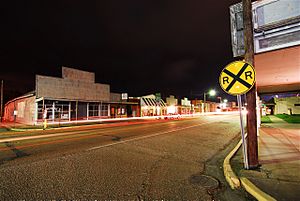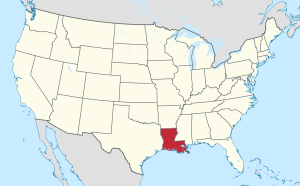Rayne, Louisiana facts for kids
Quick facts for kids
Rayne
|
|
|---|---|
| City of Rayne | |

Downtown Rayne
|
|
| Nickname(s):
Frog Capital of the World
Louisiana City of Murals |
|

Location of Rayne in Acadia Parish, Louisiana.
|
|

Location of Louisiana in the United States
|
|
| Country | United States |
| State | Louisiana |
| Parish | Acadia |
| Area | |
| • Total | 3.80 sq mi (9.84 km2) |
| • Land | 3.79 sq mi (9.82 km2) |
| • Water | 0.01 sq mi (0.02 km2) |
| Elevation | 36 ft (11 m) |
| Population
(2020)
|
|
| • Total | 7,236 |
| • Density | 1,908.23/sq mi (736.75/km2) |
| Time zone | UTC-6 (CST) |
| • Summer (DST) | UTC-5 (CDT) |
| ZIP code |
70578
|
| Area code(s) | 337 |
| FIPS code | 22-63645 |
Rayne is a city in the state of Louisiana, located in Acadia Parish. It is often called the "Frog Capital of the World." Rayne is also known as the "Louisiana City of Murals" because of its many beautiful wall paintings. In 2020, about 7,326 people lived there. Rayne is part of the larger Lafayette metropolitan area in a region called Acadiana.
Contents
History of Rayne
Rayne has a long and interesting history. It started in the late 1800s. The land was first given to French settlers in the 1700s. These early settlers mostly farmed crops like rice and sugarcane.
How Rayne Got Its Name
The city of Rayne really began to grow in the 1880s. This was when the railroad arrived. The town was first called Pouppeville. It was named after a local person. Soon after, it was renamed Rayne. This was to honor Rayne Grey. He was an engineer for the Southern Pacific Railroad. His hard work helped bring the railroad to the area. The railroad made it easier to travel and trade. It also brought many different people to the town. This helped Rayne grow and develop.
The Frog Capital of the World
Rayne became known for frogs in the early 1900s. A local businessman named Jacques Weil noticed there were many frogs nearby. He started selling frog legs to New Orleans. This business was very successful. Soon, Rayne became famous for its frog exports. This is how it got its special nickname. Over time, frogs became a big part of the city's identity.
Rayne Today
Rayne has grown and become more modern over the years. But it still has its small-town charm. The community cares about its history. It continues to celebrate its unique culture. Rayne is a great example of Louisiana's rich history. Today, Rayne is a lively community. It is known for being friendly and for its cultural festivals. It proudly shows off its Acadian heritage in Louisiana.
Geography
Rayne is located in the Acadiana region of Louisiana. It is part of the Lafayette metropolitan area. The city covers about 3.8 square miles (9.9 square kilometers). Only a very small part of this area is water.
Population and People
Rayne has seen its population change over the years. Here is how the number of people living in Rayne has changed:
| Historical population | |||
|---|---|---|---|
| Census | Pop. | %± | |
| 1890 | 569 | — | |
| 1900 | 1,007 | 77.0% | |
| 1910 | 2,247 | 123.1% | |
| 1920 | 2,720 | 21.1% | |
| 1930 | 3,710 | 36.4% | |
| 1940 | 4,974 | 34.1% | |
| 1950 | 6,485 | 30.4% | |
| 1960 | 8,634 | 33.1% | |
| 1970 | 9,510 | 10.1% | |
| 1980 | 9,066 | −4.7% | |
| 1990 | 8,502 | −6.2% | |
| 2000 | 8,552 | 0.6% | |
| 2010 | 7,953 | −7.0% | |
| 2020 | 7,326 | −7.9% | |
| U.S. Decennial Census | |||
Who Lives in Rayne?
In 2020, there were 7,236 people living in Rayne. There were 2,834 households and 1,879 families. Most people in Rayne are White or African American.
| Race | Number | Percentage |
|---|---|---|
| White (not Hispanic) | 4,428 | 61.19% |
| Black or African American (not Hispanic) | 2,429 | 33.57% |
| Native American | 21 | 0.29% |
| Asian | 25 | 0.35% |
| Pacific Islander | 2 | 0.03% |
| Other/Mixed | 217 | 3.0% |
| Hispanic or Latino | 114 | 1.58% |
In 2019, the average family size was 3.34 people. Many people in Rayne speak English. Some also speak other languages, like Spanish. The median age in the city was about 40 years old. This means half the people were older than 40 and half were younger.
Arts and Culture
Rayne is famous for its annual Frog Festival. This festival happens every year in May. It started in 1973 and brings many visitors to the city.
Rayne Frog Festival
The Frog Festival is a fun event for families. It has many activities that show off the city's unique character. You can see frog racing and jumping contests. There are also frog-eating competitions. The festival has carnival rides and live music.
Frog Art Around Town
All year long, you can find frog sculptures, murals, and statues in Rayne. These artworks celebrate the city's connection to frogs.
Tornado Strike
On March 5, 2011, an EF2 tornado hit Rayne. It caused a lot of damage to homes. Sadly, some people were hurt during the storm.
Education
The Acadia Parish School Board manages the schools in Rayne.
Schools in Rayne
- Rayne High School is located in the city. Its sports teams are called the Mighty Wolves.
- Central Rayne Kindergarten
- Martin Pettijean Elementary
- South Rayne Elementary
- Armstrong Middle School
- Rayne Catholic Elementary
Notable People
Many interesting people have come from Rayne. Here are a few:
- Musicians: Many famous Cajun and swamp pop musicians are from Rayne. These include Johnnie Allan, Lee Benoit, Amedée Breaux, Harry Choates, Joe Falcon, "Happy Fats" LeBlanc, Belton Richard, Jo-El Sonnier, Tony Thibodeaux, Lawrence Walker, and Joe Werner.
- Sports Figures: Clint Conque and Ed Zaunbrecher are American football coaches. Mike Heinen is a professional golfer. Donnie Meche, Gerard Melancon, and Elvis Perrodin are horse racing jockeys. Byron Mouton was a great basketball player. Gerald Paddio played in the NBA. Josh Reed was an NFL wide receiver for the Buffalo Bills.
- Other Notable People: Joshua Benton directs the Nieman Journalism Lab at Harvard University. Catherine Fischer is a deafblind librarian and author. Rhonda Franklin is a professor at the University of Minnesota. Margaret Rose Henry was a leader in the Delaware Senate. Dave Petitjean was a humorist and actor. Addison Rae (Easterling) is a social media star and dancer. Irene Whitfield Holmes studied music from different cultures.
Images for kids
See also
 In Spanish: Rayne (Luisiana) para niños
In Spanish: Rayne (Luisiana) para niños




